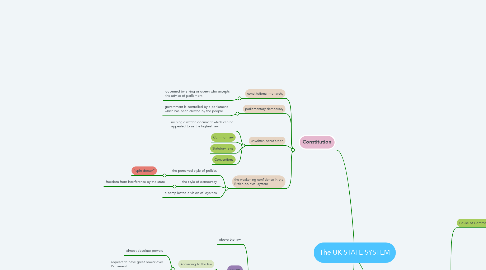
1. Constitution
1.1. constitutional monarchy
1.1.1. governed by a king or queen who accepts the advice of parliament
1.2. parliamentary democracy
1.2.1. government is controlled by a parliament which has been elected by the people
1.3. unwritten constitution
1.3.1. no single written document which can be appealed to as the highest law
1.3.2. Common law
1.3.3. Statutory laws
1.3.4. Conventions
1.4. the weakening confidence in the British political system
1.4.1. the perceived style of politics
1.4.1.1. “spin doctor”
1.4.2. the style of democracy
1.4.2.1. freedom from interference by the state
1.4.3. a complicated division of loyalties
2. Monarchy
2.1. Queen Elizabeth II
2.1.1. above the law
2.1.2. powers
2.1.2.1. According to the law
2.1.2.1.1. almost absolute powers
2.1.2.1.2. appears to have great power over Parliament
2.1.2.1.3. embodies the law in the courts
2.1.2.2. In reality
2.1.2.2.1. almost no power at all
2.1.3. roles
2.1.3.1. head of State
2.1.3.2. perform the ceremonial duties
2.1.3.3. embodiment of the government of the country
2.1.3.4. a final check on a government that was becoming dictatorial
2.1.3.5. the symbol of their nation’s unity
2.1.3.6. Head of the Commonwealth
2.1.3.7. Supreme Governor of the Church of England
2.1.3.8. chief of the armed forces
2.1.4. citizens=‘subjects’
2.1.4.1. subjects of Her Majesty the Queen
2.1.5. The Civil List
2.1.6. exempt from taxation
2.1.7. popular boss
2.1.8. spookily well-informed and observant
2.1.9. flypaper memory
2.2. a symbol of continuity and a harmless outlet for the expression of national pride
2.3. The Queen herself remains popular
2.4. The change in attitude
2.5. disappearance of old traditions
3. Parliament
3.1. House of Commons
3.1.1. The design and layout
3.1.1.1. two rows of benches facing each other
3.1.1.1.1. frontbenchers
3.1.1.1.2. backbenchers
3.1.1.2. the table between the two rows of benches
3.1.1.2.1. government and opposition
3.1.1.3. the Speaker’s chair
3.1.2. MPs (Members of Parliament)
3.1.2.1. lack of a podium or dais
3.1.2.2. no their ‘own’ place to sit
3.1.2.3. ‘the honorable Member for Winchester’ or ‘my right honorable friend’
3.1.2.4. need to have outside earnings
3.1.2.5. visit their constituencies
3.1.2.6. Whips
3.1.2.6.1. a ‘free vote’
3.1.3. Makes laws, gives authority for the government to raise and spend money, keeps a close eye on government activities and discusses those activities
3.1.4. committees
3.1.5. 8 minutes
3.1.5.1. two corridors – one is for the “Ayes” and the other is for the “Noes”
3.1.5.2. a bell ring
3.1.6. The Speaker
3.1.6.1. chairs and controls discussion, decides which MP is going to speak next and makes sure that the rules of procedure are followed
3.1.6.2. the tradition of dragging an unwilling Speaker to the chair
3.1.6.3. give up all party politics
3.1.7. Question Time
3.1.7.1. “tabled” questions
3.1.8. Standing Orders
3.1.8.1. every debate must relate to a specific “motion”
3.1.9. government and the legislature are dissolubly fused together.
3.1.10. common prayer
3.1.10.1. stand with their faces turned to the wall
3.1.10.2. can not kneel
3.2. no real power and limited influence
3.3. House of Lords
3.3.1. "life peerages"
3.3.2. "kicked upstairs"
3.3.3. a forum for discussion
3.3.4. 740 members
3.3.4.1. life-peers
3.3.4.2. bishops
3.3.4.3. elected hereditary peers
3.3.5. an offence to democratic decency
3.3.6. Chancellor’s woolsack
